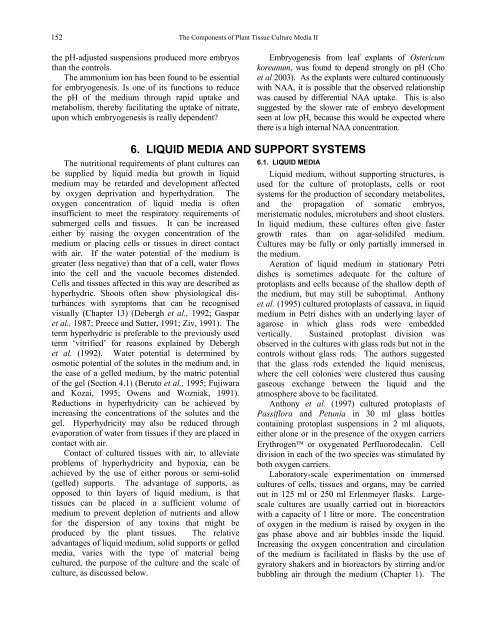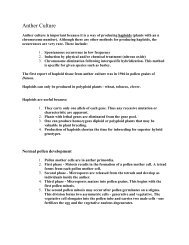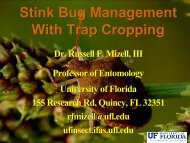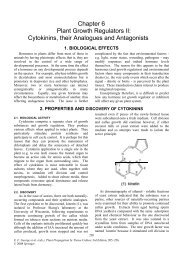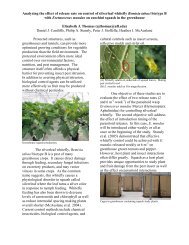The Components of Plant Tissue Culture Media II - Horticultural ...
The Components of Plant Tissue Culture Media II - Horticultural ...
The Components of Plant Tissue Culture Media II - Horticultural ...
You also want an ePaper? Increase the reach of your titles
YUMPU automatically turns print PDFs into web optimized ePapers that Google loves.
152 <strong>The</strong> <strong>Components</strong> <strong>of</strong> <strong>Plant</strong> <strong>Tissue</strong> <strong>Culture</strong> <strong>Media</strong> <strong>II</strong><br />
the pH-adjusted suspensions produced more embryos<br />
than the controls.<br />
<strong>The</strong> ammonium ion has been found to be essential<br />
for embryogenesis. Is one <strong>of</strong> its functions to reduce<br />
the pH <strong>of</strong> the medium through rapid uptake and<br />
metabolism, thereby facilitating the uptake <strong>of</strong> nitrate,<br />
upon which embryogenesis is really dependent?<br />
Embryogenesis from leaf explants <strong>of</strong> Ostericum<br />
koreanum, was found to depend strongly on pH (Cho<br />
et al 2003). As the explants were cultured continuously<br />
with NAA, it is possible that the observed relationship<br />
was caused by differential NAA uptake. This is also<br />
suggested by the slower rate <strong>of</strong> embryo development<br />
seen at low pH, because this would be expected where<br />
there is a high internal NAA concentration.<br />
6. LIQUID MEDIA AND SUPPORT SYSTEMS<br />
<strong>The</strong> nutritional requirements <strong>of</strong> plant cultures can<br />
be supplied by liquid media but growth in liquid<br />
medium may be retarded and development affected<br />
by oxygen deprivation and hyperhydration. <strong>The</strong><br />
oxygen concentration <strong>of</strong> liquid media is <strong>of</strong>ten<br />
insufficient to meet the respiratory requirements <strong>of</strong><br />
submerged cells and tissues. It can be increased<br />
either by raising the oxygen concentration <strong>of</strong> the<br />
medium or placing cells or tissues in direct contact<br />
with air. If the water potential <strong>of</strong> the medium is<br />
greater (less negative) than that <strong>of</strong> a cell, water flows<br />
into the cell and the vacuole becomes distended.<br />
Cells and tissues affected in this way are described as<br />
hyperhydric. Shoots <strong>of</strong>ten show physiological disturbances<br />
with symptoms that can be recognised<br />
visually (Chapter 13) (Debergh et al., 1992; Gaspar<br />
et al., 1987; Preece and Sutter, 1991; Ziv, 1991). <strong>The</strong><br />
term hyperhydric is preferable to the previously used<br />
term ‘vitrified’ for reasons explained by Debergh<br />
et al. (1992). Water potential is determined by<br />
osmotic potential <strong>of</strong> the solutes in the medium and, in<br />
the case <strong>of</strong> a gelled medium, by the matric potential<br />
<strong>of</strong> the gel (Section 4.1) (Beruto et al., 1995; Fujiwara<br />
and Kozai, 1995; Owens and Wozniak, 1991).<br />
Reductions in hyperhydricity can be achieved by<br />
increasing the concentrations <strong>of</strong> the solutes and the<br />
gel. Hyperhydricity may also be reduced through<br />
evaporation <strong>of</strong> water from tissues if they are placed in<br />
contact with air.<br />
Contact <strong>of</strong> cultured tissues with air, to alleviate<br />
problems <strong>of</strong> hyperhydricity and hypoxia, can be<br />
achieved by the use <strong>of</strong> either porous or semi-solid<br />
(gelled) supports. <strong>The</strong> advantage <strong>of</strong> supports, as<br />
opposed to thin layers <strong>of</strong> liquid medium, is that<br />
tissues can be placed in a sufficient volume <strong>of</strong><br />
medium to prevent depletion <strong>of</strong> nutrients and allow<br />
for the dispersion <strong>of</strong> any toxins that might be<br />
produced by the plant tissues. <strong>The</strong> relative<br />
advantages <strong>of</strong> liquid medium, solid supports or gelled<br />
media, varies with the type <strong>of</strong> material being<br />
cultured, the purpose <strong>of</strong> the culture and the scale <strong>of</strong><br />
culture, as discussed below.<br />
6.1. LIQUID MEDIA<br />
Liquid medium, without supporting structures, is<br />
used for the culture <strong>of</strong> protoplasts, cells or root<br />
systems for the production <strong>of</strong> secondary metabolites,<br />
and the propagation <strong>of</strong> somatic embryos,<br />
meristematic nodules, microtubers and shoot clusters.<br />
In liquid medium, these cultures <strong>of</strong>ten give faster<br />
growth rates than on agar-solidifed medium.<br />
<strong>Culture</strong>s may be fully or only partially immersed in<br />
the medium.<br />
Aeration <strong>of</strong> liquid medium in stationary Petri<br />
dishes is sometimes adequate for the culture <strong>of</strong><br />
protoplasts and cells because <strong>of</strong> the shallow depth <strong>of</strong><br />
the medium, but may still be suboptimal. Anthony<br />
et al. (1995) cultured protoplasts <strong>of</strong> cassava, in liquid<br />
medium in Petri dishes with an underlying layer <strong>of</strong><br />
agarose in which glass rods were embedded<br />
vertically. Sustained protoplast division was<br />
observed in the cultures with glass rods but not in the<br />
controls without glass rods. <strong>The</strong> authors suggested<br />
that the glass rods extended the liquid meniscus,<br />
where the cell colonies were clustered thus causing<br />
gaseous exchange between the liquid and the<br />
atmosphere above to be facilitated.<br />
Anthony et al. (1997) cultured protoplasts <strong>of</strong><br />
Passiflora and Petunia in 30 ml glass bottles<br />
containing protoplast suspensions in 2 ml aliquots,<br />
either alone or in the presence <strong>of</strong> the oxygen carriers<br />
Erythrogen or oxygenated Perfluorodecalin. Cell<br />
division in each <strong>of</strong> the two species was stimulated by<br />
both oxygen carriers.<br />
Laboratory-scale experimentation on immersed<br />
cultures <strong>of</strong> cells, tissues and organs, may be carried<br />
out in 125 ml or 250 ml Erlenmeyer flasks. Largescale<br />
cultures are usually carried out in bioreactors<br />
with a capacity <strong>of</strong> 1 litre or more. <strong>The</strong> concentration<br />
<strong>of</strong> oxygen in the medium is raised by oxygen in the<br />
gas phase above and air bubbles inside the liquid.<br />
Increasing the oxygen concentration and circulation<br />
<strong>of</strong> the medium is facilitated in flasks by the use <strong>of</strong><br />
gyratory shakers and in bioreactors by stirring and/or<br />
bubbling air through the medium (Chapter 1). <strong>The</strong>


